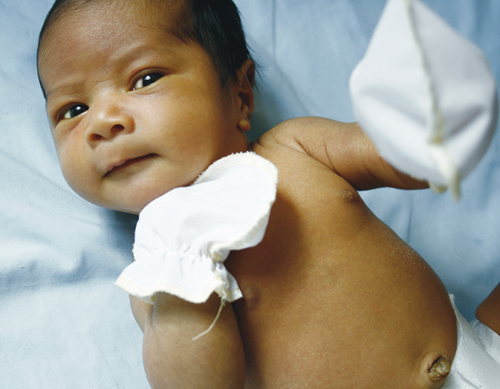Coming out

A lot happens in the moment a baby is born. […]
A lot happens in the moment a baby is born. Not only for you, but also for the new tiny human being you’ve delivered. There are people who claim they can remember their own birth, right down to the first face they saw as they left their mother’s body. But for the rest of us who might be a little fuzzy on the details, here’s a refresher about the facts surrounding a baby’s initial entry into our illuminated, air-filled world.

Before birth, your baby is accustomed to a dark, fluid-filled existence. The temperature of his quarters has been held at a toasty 98 degrees (give or take), and his ears receive only muffled sound. Food is delivered effortlessly via the umbilical cord, and aside from the minor discomfort of dealing with a cramped space, for all intents and purposes, he’s got it made in the shade. But just like an astronaut on the verge of re-entering into the earth’s atmosphere, there are some adjustments his small body will need to undergo as he moves toward the light.
Ch-ch-ch-changes
With birth comes an avalanche of new stimuli for your baby. His pint-sized world is about to be turned upside down (literally!) and to cope, he’ll first need to address a few issues.
Feeling the pressure.
Those contractions you feel during labor and delivery may be painful, but they serve an important purpose —they’re the push your baby needs to prepare to evacuate the premises. In the hours (and days) before birth, your baby is squeezed on all sides by the tightening of the uterine muscles as they intensify and grow stronger. This, along with the reduction of the surrounding fluid volume in the uterus (after your water breaks) introduces a change in pressure on your baby’s body, readying him for life on the outside.
Shifting and sliding.
The culmination of the labor contractions is the crowning moment: delivery. As your baby makes his way to the outside, his skull—which has been conveniently engineered with gaps between the plates for ease of movement—is molded into a cone-like shape, helping it fit through the narrow space. These plates will slowly shift back into place over the course of your baby’s first few days of life.
Baby, it’s cold outside.
Even if the delivery room is set at a balmy 70 degrees, it’s still almost a full 30 degrees cooler than the space your baby just evacuated, and his body most certainly feels it. Receptors in your baby’s body register this change and begin to create heat by shivering. This is why you’ll want to keep your newborn warm and dry following delivery. (Sounds like the perfect opportunity for holding baby close to your cozy chest and heating him up, mommy-style.)
Air time.
A rapid temperature change, while shocking for a newborn, is crucial—his reaction to it cues his central nervous system to make him gasp, which initiates the first breath. His respiratory and circulatory systems will go through a quick reorganization (see box below), and if all is well, you’ll know by the pink color of his cheeks and the hearty wail that will soon fill the room.
All systems go
Birth kicks your baby’s insides into overdrive. Here are some of the tireless systems working hard for your newborn following delivery:
Liver: Produces substances to help blood to clot, as well as a protein that breaks down bilirubin. (Excess bilirubin is the cause of newborn jaundice.)
Gastrointestinal system: Passes meconium (baby’s first stools). These stools rid his body of excess amniotic fluid, mucus, lanugo and bile.
Urinary system: Filters blood and produces baby’s first extra-uterine urination.
Immune system: Responds to all the new bacteria baby is encountering in the outside world and fights off potential infection.
Circulatory and respiratory systems: Give baby ability to breathe in oxygen for the first time.
Metamorphosis
Perhaps the most miraculous change your baby undergoes at birth is the transition from water dweller to landlubber. Before delivery, your baby’s oxygen supply is delivered directly into his bloodstream via the umbilical cord. Because of this, his fetal circulatory system directs his blood in a way that bypasses the unused lungs. When he draws his first breath, that pathway changes in an instant and is rerouted to include the lungs, helping them function and thrive. The amniotic fluid in the lungs is drained or absorbed, leaving room for them to fill with air and help oxygenate his body through the process of breathing.







